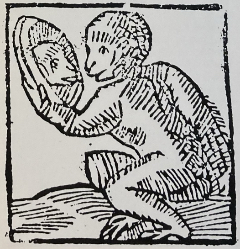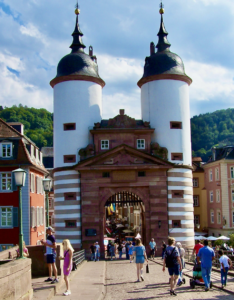
The Old Bridge, Heidelberg
Also known as the “Alte Brücke” or “Karl-Theodor-Brücke”
One of the city’s most iconic landmarks. This historic stone bridge spans the Neckar River and connecting the Altstadt (Old Town) with the northern bank. It offers stunning views of Heidelberg Castle, the river, and the surrounding hills. The fine stone bridge is 700 feet long, 30 feet broad, and its 9 arches are supported by 8 huge pillars. It is constructed of a fine red sandstone, of which most of the houses of the town and the castle were built.
History: The current version of the bridge was built in 1788 during the reign of Elector Karl Theodor. It replaced several wooden bridges each having been destroyed by floating ice blocks, floods and wars over the centuries.
The first fell victim to a flood in 1288. This type of natural disaster also put an end to other bridges. The first illustrations of bridges in Heidelberg can be found in Sebastian Münster’s work around the middle of the 16th century, Matthäus Merian’s in 1620 and Peter Friedrich de Walpergen’s around the middle of the 18th century. The bridges of that time had a wooden carriageway, were covered throughout and presumably all rested on stone pillars.
The bridge on the copperplate engraving by Merian in 1620 had three gates: the double-towered gate that is still preserved, the gate in the monkey tower and the gate on the Neuenheim side of the bridge that was added later. The monkey tower got its name from the monkey above the gate. The gate on the Neuenheim side was called the coat of arms gate because it bore the coat of arms of Frederick V and his English wife Elisabeth above its entrance. This bridge was destroyed by fire during the War of the Orleans Succession in 1689. From then on, Heidelberg had no bridge for twenty years. Traffic across the Neckar was carried on by boat bridges and ferries.
Finally, in 1708/09, the wooden bridge depicted by Walpergen was built on the old stone piers. The devastating flood of 1784 led to its destruction. Thick ice pushed its way up the icebreakers without breaking, lifting the wooden bridge from the stone piers and forcing it downstream. The present bridge was built under Elector Carl Theodor and inaugurated in 1788. It bears his statue and his name. The pillar bearing the statue of Athena was previously the site of St Nepomuk, who now adorns the Neuenheimer Ufer. The bridge builder Obristleutnant von Mylius raised the centre section of the bridge higher than the bridgeheads to prevent ice jams. He replaced the pointed roofs of the bridge towers with baroque onion domes.
In 1945, German soldiers blew up all the Neckar bridges. The Americans, who liberated Heidelberg a day later, rebuilt the Old Bridge and it was inaugurated in 1947. It was rebuilt again in 1969 the archway being unsuitable for modern traffic. Today it is used by pedestrians and cyclists.
Excerpts From: Helmina von Chézy. “Manual for Travellers to Heidleberg and Its Environs”
“A French army invaded the Palatinate, Occupying Heidelberg Oct. 24, 1688, and, in spite of all promises, put it under contribution, and devastated it unmercifully. In the town the armoury, the mews, the magnificent townhouse, together with many other houses, were committed to the flames, and even the noble bridge across the Neckar was destroyed.”
” . . . . A covered bridge occupied originally the site of the present one, but being destroyed by the breaking up of the ice (1784), they began the present one, which was finished already in 1788.”
Heidelberg’s Bridge Monkey
 The story of Heidelberg’s Bridge Monkey dates back to the 15th century. Even then, there was a monkey sitting in the tower of the Old Bridge. The tower, which then stood opposite Heidelberg’s Old Town, was intended to instill feelings of fear and respect in anyone arriving in the town. The monkey however, was particularly intended to mock.
The story of Heidelberg’s Bridge Monkey dates back to the 15th century. Even then, there was a monkey sitting in the tower of the Old Bridge. The tower, which then stood opposite Heidelberg’s Old Town, was intended to instill feelings of fear and respect in anyone arriving in the town. The monkey however, was particularly intended to mock.
Grasping his bare backside, he showed the “Electoral Palatinate Greeting” to people walking past. His backside was pointed in the direction of the opposite river bank, towards the town of Mainz and so, his “greeting” was rather pointedly addressed to the Bishops of Mainz. This is how the people of Heidelberg made it clear that it was the Electors of the Palatinate, and not the Bishops in Mainz, who held the power. The mirror in the monkey’s hand was intended to encourage passers-by to engage in critical selfreflection.
Today, you can still see the poem by Martin Zeiller (1589-1661) which was written beside the monkey in the 17th century:
“Why are you looking at me? Haven‘t you seen a monkey in Heidelberg? Look around and you will probably see – many more monkeys like me!”
Construction: Made of Neckar sandstone, it is considered a fine example of classical stone bridge architecture.
Statues: Two statues adorn the bridge, producing a peculiar effect at night time, especially when the sun is setting, or the moon rising. One of the two statues, facing the town, is enclosed in an iron railing and represents the elector Charles Theodor, in whose reign the bridge was built; at his feet the Gods and Goddesses of the rivers: Rhine, Neckar, Danube and Mosella, are reposing. The other statue represents the figure of Minerva, the Goddess of wisdom, at whose feet likewise symbolical figures representing the four faculties of the university repose. Both statues, together with the by-figures, were executed by Link, the then sculptor to the court, at Mannheim. They were damaged in the French siege in (1799), the marks of the cannonballs can still be seen in the statue of Charles Theodor. These sculptures symbolize wisdom and the ruler’s contributions to the city. On the other side of the bridge, on the way to Ziegelhausen, stands a statue of St. Nepomuck. Also at the northern entrance to the bridge, – the Heidelberg Bridge Monkey: the a famous sculpture of a monkey holding a mirror. It’s said to bring good luck and serves as a reminder to visitors to reflect on their actions and humility.
Views: The Old Bridge is a favorite amongst tourists, photographers, and locals alike. From the bridge, you can see the picturesque Heidelberg Castle perched on the hillside and the charming rooftops of the Old Town, especially at sunset when the scenery becomes even more magical. For even better views, cross the bridge and follow the steep zig-zag Schlangenweg up to the Philosophers Walk which runs parallel to the river half way up the Heiligenberg.
